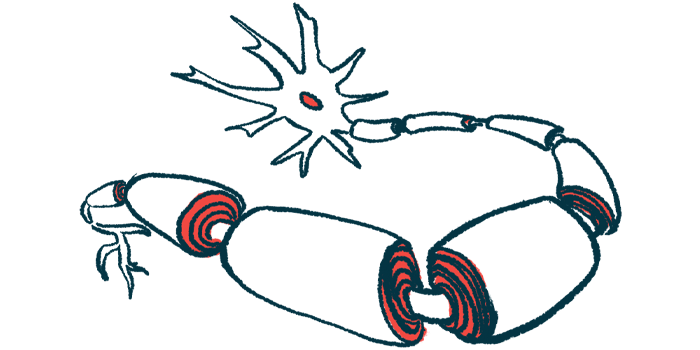Neurofilaments, Nerve-muscle Test Reflect SMA Severity in Very Young

The blood levels of neurofilaments — a marker of nerve cell damage — and the results of a nerve-muscle test called compound muscle action potential (CMAP) may serve as a biomarker of disease onset and treatment response in infants and children with spinal muscular atrophy (SMA) up to 3 years old, a study suggests.
In addition, in infants with SMA type 1, the therapy Zolgensma was unexpectedly associated with a temporary rise in neurofilament levels that was prevented in children who started Spinraza (nusinersen) shortly prior to the gene therapy.
Still, most infants treated with Zolgensma showed increases only in CMAP — indicative of better nerve-muscle health — and acquired age-appropriate motor milestones, highlighting the therapy’s effectiveness despite the abnormal neurofilament increase.
These findings support the biomarker potential of neurofilaments and CMAP in SMA patients’ early life and call for more studies to assess the effects of different SMA treatment combinations, including those involving Evrysdi (risdiplam).
The study, “Implications of Circulating Neurofilaments for Spinal Muscular Atrophy Treatment Early in Life: A Case Series,” was published in the journal Molecular Therapy – Methods & Clinical Development.
With the emergence of three disease-modifying therapies for SMA — Biogen’s Spinraza, Novartis’ gene therapy Zolgensma, and Roche’s Evrysdi — and the established importance of early diagnosis and treatment to prevent further damage, identifying biomarkers to monitor disease activity and treatment responses early in life is critical.
Higher levels of neurofilaments, major structural proteins of neurons, are indicative of nerve cell damage and have been suggested as potential prognostic and treatment response biomarkers in SMA.
However, changes in blood neurofilament levels after Zolgensma or combination therapy remain largely unclear.
To address this, Biogen and researchers at the Massachusetts General Hospital’s Center for Genomic Medicine, in Boston, analyzed the levels of two major neurofilament subunits — phosphorylated neurofilament heavy chain (pNF-H) and neurofilament light chain (NfL) — in 90 SMA patients younger than age 3 and 22 age-matched healthy controls.
Among children with SMA, 68 had not received prior treatment, and nine were treated with Spinraza, seven with Zolgensma, and six with Spinraza followed by the gene therapy.
While both therapies work to increase the levels of SMN, the protein missing in SMA, the one-time therapy Zolgensma does so by delivering to cells a working copy of SMN1, the mutated disease-causing gene, and Spinraza, given three times a year, targets the SMN2 “backup” gene.
Given Evrysdi’s more recent approval, none of the children included in the study had received this oral therapy.
Ulnar nerve test
The researchers also looked at ulnar CMAP, a test that measures muscle response to stimulation of the ulnar nerve, which controls wrist and finger movement. CMAP typically correlates with SMA severity, with lower values indicating greater damage to motor neurons, the specialized nerve cells that control voluntary movements and that are progressively lost in SMA.
The children’s demographic information, clinical data, and blood samples were retrieved from the SPOT SMA Longitudinal Pediatric Data Repository (NCT02831296) database and linked biorepository. Launched in 2016, SPOT SMA was designed to collect and analyze data from 1,000 SMA patients younger than 3 and their healthy siblings 10 or older that may help improve care in this patient population.
Consistent with previous studies, results showed that the levels of both pNf-H and Nf-L were significantly higher in children with SMA relative to age-matched controls, and that they were linked to disease severity — as measured with SMN2 gene copy number and ulnar CMAP values.
SMN2 copy number is the main disease modifier used to predict disease severity in newborns with SMA; typically, the more SMN2 copies a patient has, the less severe is the disease.
The data also confirmed that Spinraza treatment leads to a fast drop in blood neurofilament levels, supporting their potential to be used as treatment response biomarkers.
However, to the researchers’ surprise, six of the seven children treated with Zolgensma only showed an increase in both pNf-H and Nf-L levels right after treatment, regardless of SMN2 copy number. While these levels dropped in the following weeks, “they remained above normal in 5 of 6 patients,” the researchers wrote.
Zolgensma “may be causing acute collateral damage to vulnerable neurons during a critical period of vulnerability in the setting of an enhanced cellular stress response,” the team hypothesized.
Notably, among the six infants with SMA type 1 treated with the Spinraza-Zolgensma combo, those who received Zolgensma one or two weeks after Spinraza initiation showed a reduction in neurofilaments.
A longer interval period was associated with an increase in pNf-H and Nf-L levels that, nevertheless, was milder than that observed in children given Zolgensma only.
These findings suggest that pre-treatment with Spinraza may “prevent or reduce the impact of elevated NFs [neurofilaments] temporally associated with [Zolgensma],” the researchers wrote.
Importantly, all treatments were associated with increased ulnar CMAP values and significant motor function improvements, with treated children achieving CMAP values and motor milestones not attained by untreated patients.
Still, a combination of chronically high neurofilament levels and low ulnar CMAP values appeared to “predict a less than ideal outcome despite early [Zolgensma] monotherapy,” the team wrote.
“Identifying such infants early to ensure optimal clinical support and consider adjunct therapeutic approaches could result in improved clinical outcomes,” they added.
These new findings “provide evidence to support the use of [blood] NFs and maximum ulnar CMAP as biomarkers to monitor SMA disease onset, progression and treatment response early in life in the clinical setting,” the researchers wrote.
More studies are needed to better understand the mechanisms behind these findings and to clarify the effects of gene therapy alone or in combination with not only Spinraza, but also Evrysdi, the researchers noted.
Three of the study’s authors are current or former employees of Biogen.








